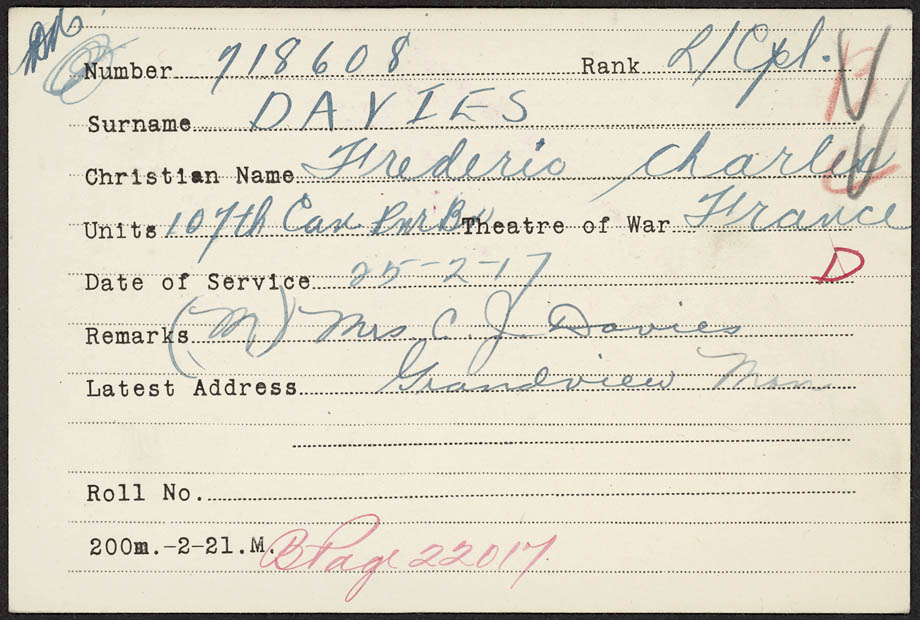
First World War Medal Card.Library and Archives Canada,RG 150, accession 1992-93/166,box 2340-35.
The sample document is taken from the service file of 718608, Frederic Charles Davies, who was killed in action on 4 March 1918 on the Western Front. He received the British War Medal and the Victory Medal, but he was not eligible for the 1914-1915 Star. One can determine these awards from his medal card in the following way:
- In the upper right corner there is a capital B, with a check mark through it. The "B" denotes that Mr. Davies was awarded the British War Medal, and the check mark denotes that it was sent out.
- In the same corner is a capital V, also with a check mark. As with the "B", the "V" denotes the award of the Victory Medal, and the check mark that it was sent out.
Note: Should only one letter appear, this means that only one of the medals has been awarded, most likely the British War Medal.
- Eligibility for the 1914-1915 Star is determined by Theatre of War and Date of Service. If Theatre of War reads France, and Date of Service shows a date before 31 December 1915, the soldier is eligible for the Star. In this case, we can see that Mr. Davies was not transferred to France until 25 February 1917, and is therefore not eligible for the Star.
Note: If Theatre of War reads England, and the Date of Service is before 11 November 1918, the soldier is only eligible for the British War Medal, and only a "B" will appear in the upper right corner. Soldiers who never left Canada are not eligible for any service awards, and consequently there is no medal card in their service files.
Criteria for the Award of First World War Theatre Medals
- 1914-1915 Star: Granted to all officers and men who actively served on the establishment of a unit in a Theatre of War, for example France or Belgium, between midnight 22 November 1914 and midnight 31 December 1915.
- British War Medal: Granted to all officers and other ranks, who either entered a Theatre of War on duty, or left places of residence and rendered approved service overseas, on or before midnight 11 November 1918. All veterans of the Canadian Expeditionary Force who proceeded to the United Kingdom were eligible for the award in the regulations. The medal was also awarded to all Naval personnel who performed 28 days mobilized service anywhere. Also awarded to those who proceeded to the British West Indies and to Siberia.
- Victory Medal: Granted to all officers and other ranks who actually served on the establishment of a unit in a Theatre of War on or before midnight 11 November 1918, and to those officers and other ranks of the Canadian Expeditionary Force who proceeded to Siberia.
Note: Decorations such as a Mentioned-in-Despatches, Military Medal or Military Cross, Distinguished Service Order, etc. do not appear on the medal card, but are entered on the individual's Record of Service and Casualty forms, along with the number of the London Gazette in which the award was promulgated.